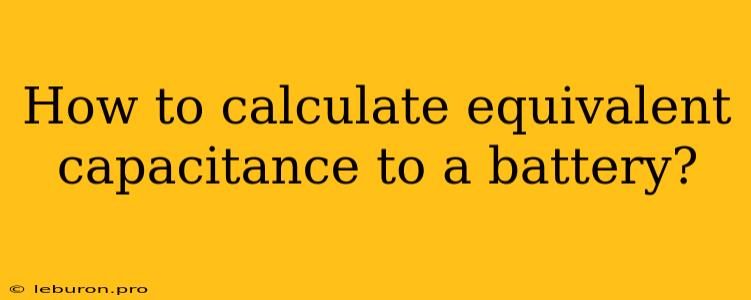Capacitors are essential components in electronic circuits, playing a crucial role in energy storage and filtering. In many applications, multiple capacitors are connected together to achieve a desired capacitance value. Understanding how to calculate the equivalent capacitance of a combination of capacitors is fundamental for circuit design and analysis. This article will delve into the methods for determining the equivalent capacitance of capacitors connected in series and parallel, providing practical examples to illustrate the concepts.
Understanding Capacitance
Before exploring equivalent capacitance, let's revisit the concept of capacitance itself. Capacitance is a measure of a capacitor's ability to store an electrical charge. It is defined as the ratio of the charge stored on a capacitor to the voltage across it. The unit of capacitance is the Farad (F), which is a large unit. In practice, capacitors are typically measured in microfarads (µF), nanofarads (nF), or picofarads (pF).
Capacitors in Series
When capacitors are connected in series, they are arranged in a chain, one after the other. In this configuration, the same amount of charge flows through each capacitor, but the voltage is divided across them. The equivalent capacitance of capacitors in series is always less than the smallest individual capacitance.
Formula for Capacitors in Series
The equivalent capacitance (Ceq) of capacitors connected in series is calculated using the following formula:
1/Ceq = 1/C1 + 1/C2 + 1/C3 + ... + 1/Cn
Where:
- Ceq is the equivalent capacitance
- C1, C2, C3, ... Cn are the individual capacitances
Example of Capacitors in Series
Let's consider an example with three capacitors connected in series. The individual capacitances are C1 = 2 µF, C2 = 4 µF, and C3 = 6 µF. To find the equivalent capacitance, we can use the formula:
1/Ceq = 1/2 µF + 1/4 µF + 1/6 µF
Solving for Ceq, we get:
Ceq = 1.14 µF
Therefore, the equivalent capacitance of these three capacitors in series is 1.14 µF.
Capacitors in Parallel
In a parallel configuration, capacitors are connected side-by-side. In this arrangement, the voltage across each capacitor is the same, but the charge is distributed among them. The equivalent capacitance of capacitors in parallel is always greater than the largest individual capacitance.
Formula for Capacitors in Parallel
The equivalent capacitance (Ceq) of capacitors connected in parallel is simply the sum of the individual capacitances:
Ceq = C1 + C2 + C3 + ... + Cn
Where:
- Ceq is the equivalent capacitance
- C1, C2, C3, ... Cn are the individual capacitances
Example of Capacitors in Parallel
Let's consider an example with the same three capacitors from the previous example, but now connected in parallel. The individual capacitances are still C1 = 2 µF, C2 = 4 µF, and C3 = 6 µF. To find the equivalent capacitance, we use the formula:
Ceq = 2 µF + 4 µF + 6 µF
This results in:
Ceq = 12 µF
Therefore, the equivalent capacitance of these three capacitors in parallel is 12 µF.
Practical Applications of Equivalent Capacitance
Understanding how to calculate equivalent capacitance is crucial for various practical applications in electronics, including:
- Circuit Design: When designing circuits, it is essential to choose the appropriate capacitance values for different components. Calculating the equivalent capacitance allows for accurate circuit analysis and optimization.
- Battery Backup Systems: In battery backup systems, capacitors are often used to provide short-term power in case of a power outage. Calculating the equivalent capacitance of multiple capacitors allows for the design of a system that can provide the required backup power.
- Filtering: Capacitors are widely used for filtering unwanted frequencies in electronic circuits. By calculating the equivalent capacitance of a filter network, designers can achieve the desired filtering characteristics.
Conclusion
Calculating the equivalent capacitance of capacitors connected in series or parallel is a fundamental skill for electronics enthusiasts and professionals. By understanding the formulas and principles discussed in this article, you can effectively analyze and design circuits incorporating multiple capacitors. Whether you are working on simple circuits or complex systems, the ability to determine equivalent capacitance is essential for achieving desired circuit performance and functionality.
